
94% of researchers rate our articles as excellent or good
Learn more about the work of our research integrity team to safeguard the quality of each article we publish.
Find out more
ORIGINAL RESEARCH article
Front. Chem. , 23 September 2020
Sec. Theoretical and Computational Chemistry
Volume 8 - 2020 | https://doi.org/10.3389/fchem.2020.585753
This article is part of the Research Topic Computational Modeling of Spintronic Materials View all 18 articles
 Li Zhang1*
Li Zhang1* Kai Wang2,3*
Kai Wang2,3*Type II nodal line states have novel properties, such as direction-reliant chiral anomalies and high anisotropic negative magneto-resistance. These type II nodal line states have been widely investigated. Compared to nodal line materials, there are far fewer proposed nodal surface materials, and furthermore, a very recent challenge is to find a realistic material that co-exhibits both nodal line and nodal surface states. In this manuscript, we present the study of the electronic and topological states of pure zirconium within the density functional theory. We found that pure Zr is an interesting material that rarely exhibits both the type II nodal line state (in kz = 0 plane) and nodal surface state (in kz = π plane). The nontrivial topological states are explained based on the orbital-resolved band structures. Our study shows that pure Zr can serve as a new platform to investigate the interplay between the nodal line state and the nodal surface state.
Topological semimetals and topological metals (Fang et al., 2016; Yan and Felser, 2017; Schoop et al., 2018; Zhou et al., 2018; Gao et al., 2019; Hu et al., 2019; Klemenz et al., 2019; Pham et al., 2019; Xie et al., 2019; Yi et al., 2019) have been widely investigated because they can be regarded as good candidates for use in the areas of spintronics and quantum computers. Weyl and Dirac materials (Ouyang et al., 2016; Zhong et al., 2016; Zhou et al., 2016; Liu et al., 2017; Fu et al., 2018; Meng et al., 2019, 2020a; Zhang et al., 2020), which host 2-fold and fourfold degenerate band-crossing points, have been explored in real materials and their exotic properties have been confirmed in experiments. Moving forward, a series of three-dimension materials, with 1D and 2D band crossing points, have been predicted to be nodal line semimetals/metals (Phillips and Aji, 2014; Gan et al., 2017; Jin et al., 2017, 2019, 2020; Lu et al., 2017; Yang et al., 2017; Chen et al., 2018; Gao et al., 2018; Liu et al., 2018) and nodal surface semimetals/metals (Wu et al., 2018; Zhang et al., 2018; Wang et al., 2020), respectively.
Moreover, topological semimetals/metals can also be classified by the tilting degree of the fermion cone. Hence, Weyl materials can be roughly divided into two main categories, namely, type I Weyl semimetals/metals (Osterhoudt et al., 2019) where the two bands have opposite velocities and type II Weyl materials (Soluyanov et al., 2015; Ma et al., 2019) where the two bands have the same velocity. Type II Weyl materials are expected to exhibit many interesting features (Koepernik et al., 2016; Yu et al., 2016; Sharma et al., 2017), such as signals in magneto-oscillations, anisotropic chiral anomalies, and an unusual magneto-response.
Besides the two types of Weyl materials, a third type exists, named hybrid Weyl materials (Alisultanov, 2018), in which one Weyl point is type I while the other one is type II. Similar to Weyl materials, nodal line materials are composed of numerous band crossing points and they can also be classified as type I, type II, and hybrid types on the basis of the band dispersion around the band crossing points.
Nodal surface materials have been proposed in some 3D materials with different families, such as the Ti3Al family (Zhang et al., 2018), BaVS3 family (Liang et al., 2016), and HfIr3B4 (Wang et al., 2020). The predicted nodal surface materials are far fewer, compared to nodal line and nodal point materials. What is more, up to now, there has been no experimental verification of nodal surface materials. Noted that the nodal surface properties can be predicted among magnetic materials due to the bands for each spin channel can be effectively seen as a spinless system with a chosen spin polarization axis. Therefore, nodal surface materials can be seen as good candidates for using in spintronic.
In this manuscript, we aim to present a first-principle study of the electronic structures and the topological signatures of a new metal (i.e., pure Zr) co-featuring the type II nodal line state and the nodal surface state. Importantly, P63/mmc Zr is a realistic material and its experimental lattice constants are a = b = 3.232 Å; c = 5.147 Å, respectively (Wyckoff, 1963). Our results provide a realistic material platform for exploring the fundamental physics of type II nodal line and nodal surface states, and their hybridization.
We performed this study by the following main steps: (i) We investigated the most stable configuration by volume optimization and calculation of lattice parameters for P63/mmc Zr, (ii) We computed band structures, including the 2D band structure along Γ-M-K-Γ-A-L-H-A high-symmetry points and the orbital-resolved band structures. These two investigations were completed with the Vienna ab initio Simulation Package (Sun et al., 2003). Volume optimizations and lattice parameter estimations were carried out with the generalized gradient approximation (GGA) (Perdew et al., 1996) of the Perdew–Burke–Ernzerhof (PBE) functional (Perdew et al., 1998). The cutoff energy was set as 600 eV. The Brillouin zone was sampled by a Monkhorst–Pack k-mesh with a size of 11 × 11 × 6. The self-consistent field convergence for the total energy and the force variation were set as 1 × 10−6 eV and 0.00001 eV·Å−1, respectively.
Experimentally, Zr is a realistic material and it naturally shares a hexagonal phase, with 194 space group numbers, a P63/mmc space group, and a series of ICSDs (such as 653524, 653525, 653528, 653529)1. The crystal structure of Zr was fully relaxed before the band-structure calculation. The crystal model as well as the atomic positions were determined and are shown in Figure 1A. From this, one can see that this crystal model contains two Zr atoms; one located at the (0.6666, 0.3333, 0.75) position, and the other located at the (0.3333, 0.6666, 0.25) position. The achieved optimized lattice constants are a = b = 3.234 Å; c = 5.161 Å, respectively, which are in good agreement with the experimental ones (Wyckoff, 1963). The calculated electronic density of states of Zr is shown in Figure S1, the metallic properties of Zr can be observed due to a large peak appears around the Fermi level.
We first consider the electronic band structure of pure Zr in the absence of spin-orbit coupling. The GGA-PBE result for the band structure along Γ-M-K-Γ-A-L-H-A high-symmetry points (see Figure 1B) is exhibited in Figure 2. From this figure, one can see the metallic behavior of this material with some obvious band crossing points. These band crossing points are formed by the overlapping between band 1 (labeled as 1) and band 2 (labeled as 2). These two bands belong to the irreducible representations A1 and B2 of the C2v symmetry. Furthermore, these band crossing points are mainly located at two regions, named as A1 and A2, respectively. In Figure S2, the band structure of Zr metal under experimental lattice constants is also computed via GGA method and one can see that these band-crossing points are still retained.
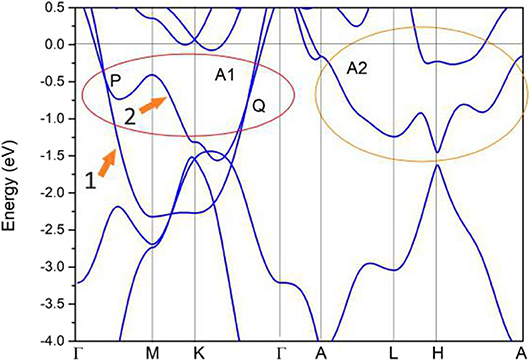
Figure 2. Band structure of pure Zr via the GGA-PBE method. A series of band crossing points can be found near the Fermi level, and these band crossing points are divided into two regions (i.e., region A1 and region A2).
In the A1 region, two band crossing points (i.e., P and Q) can be found along the Γ-M and M-K paths, respectively. All of these band crossing points are located quite close to the Fermi level. Because the pure Zr system enjoys spatial inversion and time reversal symmetries, the P and Q band crossing points belong to a nodal line instead of isolated points (Jin et al., 2019). Moreover, the Γ-M and M-K paths are situated in the mirror-invariant plane kz = 0, which can protect a nodal line.
The enlarged band structures (in the absence of spin-orbital coupling) around P and Q band crossing points are given in Figures 3A,B, respectively. Around these band crossing points, the band structures host a large linear energy region (see Figures 3A,B). Based on the slopes of the involved bands in crystal momentum space around the band crossing points P and Q, one can see that they belong to type II. To determine whether P and Q band crossing points are isolated nodal points or belong to a nodal line, the shape of the nodal line at the kz = 0 plane is exhibited in Figure 4. From this figure, a Γ-centered nodal line (highlighted by the white line) can be obviously observed at the kz = 0 plane.
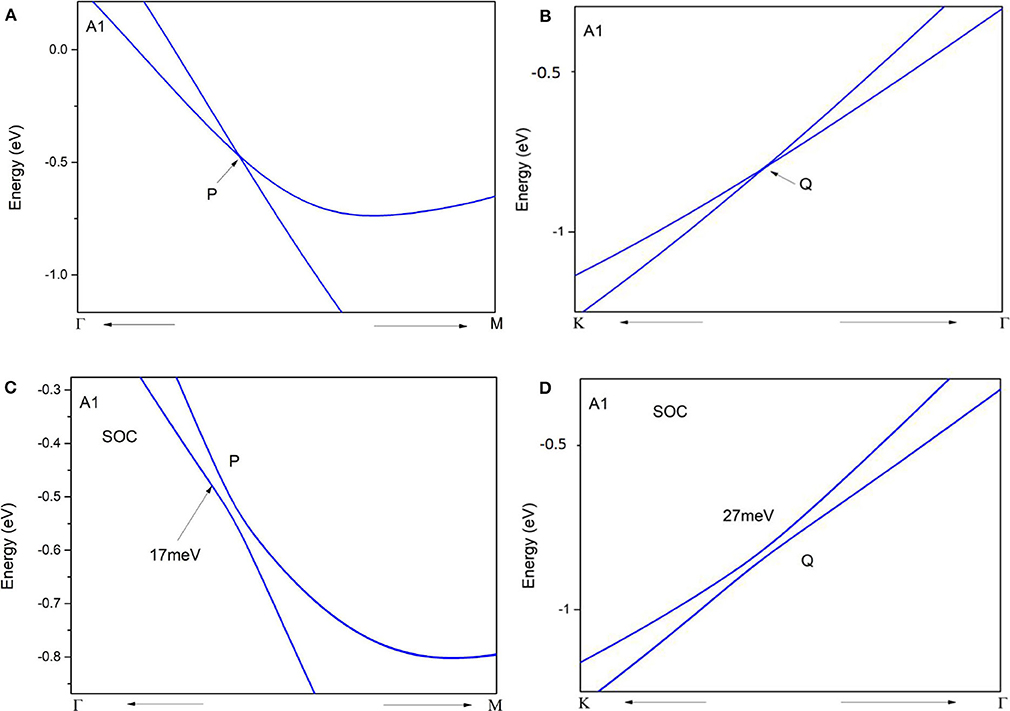
Figure 3. Enlarged band structures of pure Zr via the GGA-PBE method along Γ-M (A,C) and M-K (B,D) paths, respectively. The band structures calculated in (A–D) do not have spin–orbit coupling (have spin–orbit coupling).
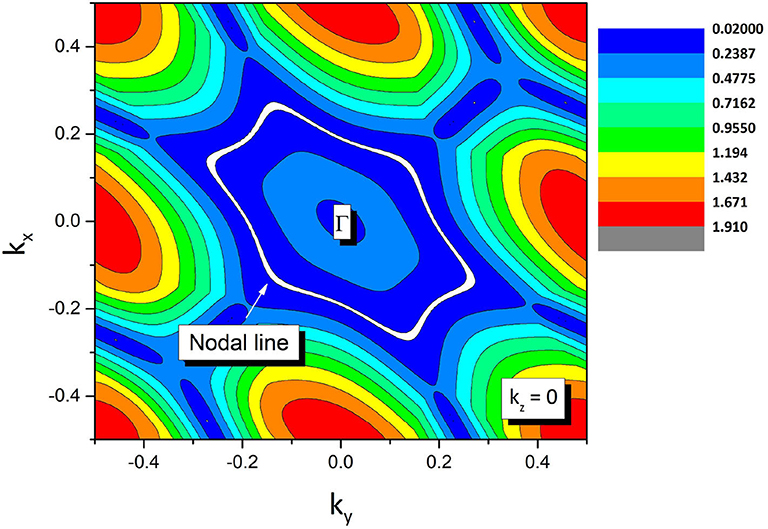
Figure 4. The shape of the nodal line at the kz = 0 plane. The Γ-centered nodal line is marked as a white line.
One should note that the nodal line state is protected by two independent mechanisms for Zr system: one is the spatial inversion and the time reversal symmetries; the other one is mirror symmetry Mz, because the two crossing bands have opposite mirror eigenvalues. Therefore, the nodal line state in the Zr system is robust because Zr hosts two kinds of symmetry-protected mechanisms. That is, if we break only one kind of symmetry protection, the nodal line state will be retained. The same symmetry protection mechanism has also been reported in previous work, such as TiB2 with the type I nodal line state (Zhang et al., 2017).
The SOC effect was also taken into consideration in the Zr system in region A1, and the calculated band structures around P and Q band crossing points are given in Figures 3C,D, respectively. From these figures, one can see that the SOC-induced gaps around P and Q are ~17 and ~27 meV, respectively. We noted that these opened gaps around the band crossing points are indeed small and these values of Zr are smaller than the values of some previously proposed nodal line materials (Meng et al., 2020b), such as Cu3NPd (60–100 meV), CaAgBi (80–140 meV), BaSn2 (60–160 meV).
The band structure of pure Zr along A-L-H-A paths is given without SOC in Figure 5A. In region A2, there are two bands linearly crossing at the A point, and they then become degenerate in plane kz = π forming a nodal surface. The nodal surface state is essential because it can be indicated by symmetry (i.e., the non-symmorphic S2z and the time reversal symmetries T). Consider the twofold screw rotation S2z in pure Zr, S2z (x,y,z)→(-x,-y,z+1/2). In the kz = π plane, each k point is invariant under S2zT. Because (S2zT)2 = T001 = on plane kz = π, the bands on this plane have a Kramer-like degeneracy. A nodal surface can be also understood as a result of Kramer degeneracy.
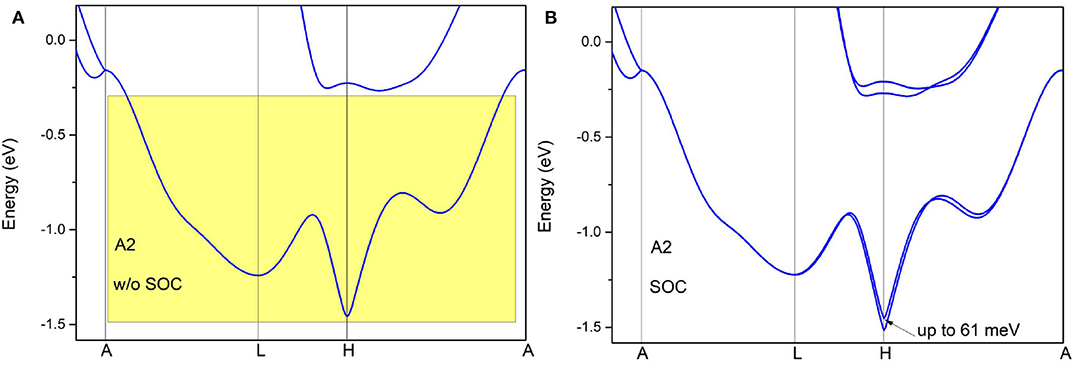
Figure 5. Band structures of pure Zr via the GGA-PBE method along A-L-H-A paths. The band structures calculated in (A,B) are without spin–orbit coupling (with spin–orbit coupling).
To further confirm the nodal surface state in the kz = π plane, the band structure along the A-M-L-R paths (see the insert figure in Figure 6) is given in Figure 6. From it, one can see that the two bands are also degenerated with each other in this plane, which results in a nodal surface state in plane kz = π. The effect of spin–orbit coupling (SOC) on the electronic structure is examined and the results of band structure along A-L-H-A (with SOC) are given in Figure 5B. The values of the SOC-induced gaps along A-L-H-A directions are up to 61 meV. The gaps in Zr are smaller than those in some topological materials (Meng et al., 2020b), such as Cu3NPd (60–100 meV), and BaSn2 (60–160 meV).
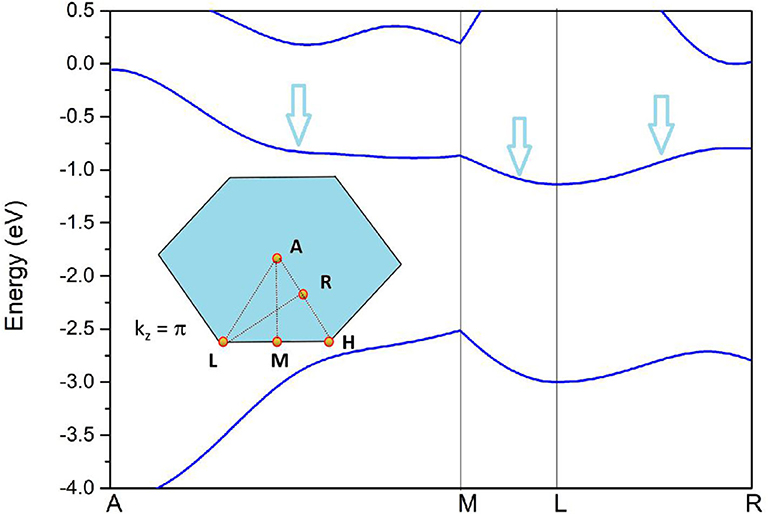
Figure 6. Band structures of pure Zr via the GGA-PBE method along A-M-L-R paths. The insert figure is selected k-paths at the kz = π plane.
Finally, the orbital-resolved band structures of Zr-dxy, Zr-dyz, Zr-dxz, , orbitals are given in Figure 7. One can see that band 1 (see Figure 2) is mainly coming from the hybridization between the Zr-dyz and Zr-dxz orbitals. However, band 2 forms the hybridization among Zr-dxy, , orbitals. In the A1 region, as shown in Figure 7, the band crossing point P is mainly coming from Zr-dxz and Zr-dxy orbitals, however, the band crossing point Q is mainly arising from the Zr-dyz and orbitals. In region A2, the band crossing points of the surface states (kz = π plane) are dominated by the orbital, however, the contribution of other orbitals of Zr atom cannot be ignored.
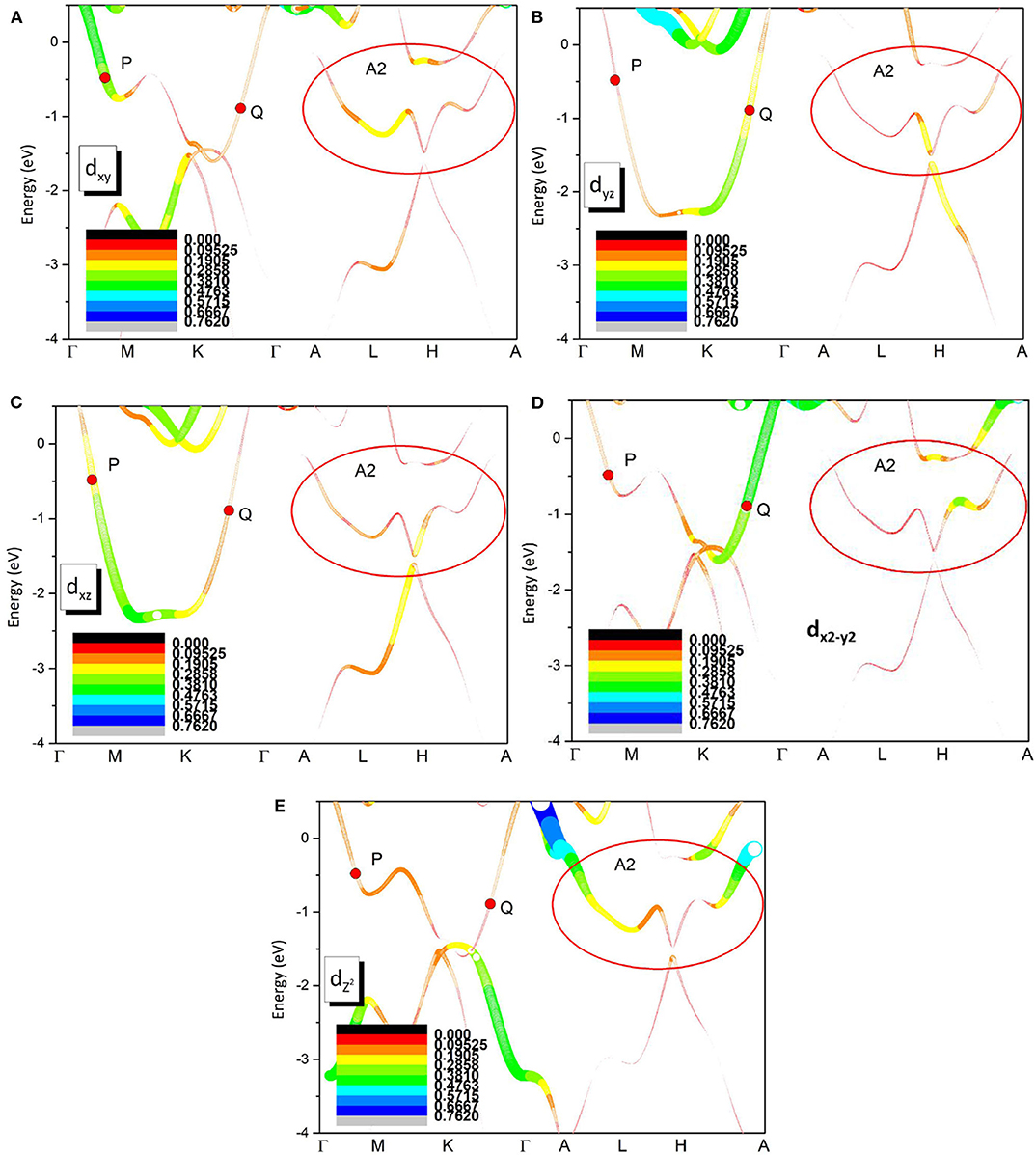
Figure 7. Orbital resolved band structures of pure Zr via the GGA-PBE method along A-M-L-R paths. (A–E) are for Zr-dxy, Zr-dyz, Zr-dxz, , Zr- orbitals, respectively.
In conclusion, based on symmetry analysis and first-principle calculations, we have shown a realistic material, pure Zr, which features a type II nodal line state at the kz = 0 plane and a nodal surface state at the kz = π plane when the SOC effect is ignored. The nodal line state at the kz = 0 plane is protected by the spatial inversion, time reversal, and horizontal mirror symmetries. The nodal surface state at the kz = π plane is protected by the screw rotation and time reversal symmetries. The effect of SOC on the topological nodal line and nodal surface states was tested and the SOC-induced band gaps for both A1 and A2 regions were found to be smaller than 61 meV.
The orbital-resolved band structures of Zr-dxy, Zr-dyz, Zr-dxz, , orbitals for the pure Zr system were exhibited. In region A1, the point P is mainly coming from Zr-dxz and Zr-dxy orbitals, however, the point Q is mainly arising from the Zr-dyz and orbitals. In region A2, the surface states (kz = π plane) are dominated by the orbital, however, the contribution of other orbitals of the Zr atom cannot be ignored.
All datasets generated for this study are included in the article/Supplementary Material.
LZ: conceptualization, methodology, software, formal analysis, data curation, and writing. KW: investigation, funding, and project administration. All authors contributed to the article and approved the submitted version.
This work was supported by National Natural Science Foundation of China (grant number: 81601541), National Natural Science Foundation of Heilongjiang Province (grant number: LH2020H067), Topic Foundation of Changchun Institute of Technology (grant number: 320200040), and Young People Foundation of Changchun Institute of Technology (grant number: 320200033).
The authors declare that the research was conducted in the absence of any commercial or financial relationships that could be construed as a potential conflict of interest.
The Supplementary Material for this article can be found online at: https://www.frontiersin.org/articles/10.3389/fchem.2020.585753/full#supplementary-material
1. ^Available online at: https://materialsproject.org/materials/mp-131/
Alisultanov, Z. Z. (2018). Hybrid Weyl semimetal under crossed electric and magnetic fields: field tuning of spectrum type. Phys. Lett. A 382, 3211–3215. doi: 10.1016/j.physleta.2018.08.028
Chen, H., Zhang, S., Jiang, W., Zhang, C., Guo, H., Liu, Z., et al. (2018). Prediction of two-dimensional nodal-line semimetals in a carbon nitride covalent network. J. Mater. Chem. 6, 11252–11259. doi: 10.1039/C8TA02555J
Fang, C., Lu, L., Liu, J., and Fu, L. (2016). Topological semimetals with helicoid surface states. Nat. Phys. 12, 936–941. doi: 10.1038/nphys3782
Fu, C., Guin, S. N., Watzman, S. J., Li, G., Liu, E., Kumar, N., et al. (2018). Large Nernst power factor over a broad temperature range in polycrystalline Weyl semimetal NbP. Energy Environ. Sci. 11, 2813–2820. doi: 10.1039/C8EE02077A
Gan, L., Wang, R., Jin, Y. J., Ling, D. B., Zhao, J., Xu, W. P., et al. (2017). Emergence of topological nodal loops in alkaline-earth hexaborides XB6 (X = Ca, Sr, and Ba) under pressure. Phys. Chem. Chem. Phys. 19, 8210–8215. doi: 10.1039/C6CP08421D
Gao, H., Venderbos, J. W., Kim, Y., and Rappe, A. M. (2019). Topological semimetals from first-principles. Ann. Rev. Mater. Res. 49, 153–183. doi: 10.1146/annurev-matsci-070218-010049
Gao, Y., Xie, Y., Chen, Y., Gu, J., and Chen, Z. (2018). Spindle nodal chain in three-dimensional α′ boron. Phys. Chem. Chem. Phys. 20, 23500–23506. doi: 10.1039/C8CP03874K
Hu, J., Xu, S., Ni, N., and Mao, Z. (2019). Electronic transport and quantum oscillation of topological semimetals. Ann. Rev. Mater. Res. 49, 207–252. doi: 10.1146/annurev-matsci-070218-010023
Jin, L., Zhang, X., He, T., Meng, W., Dai, X., and Liu, G. (2019). Topological nodal line state in superconducting NaAlSi compound. J. Mater. Chem. C 7, 10694–10699. doi: 10.1039/C9TC03464A
Jin, L., Zhang, X., He, T., Meng, W., Dai, X., and Liu, G. (2020). Electronic structure, doping effect and topological signature in realistic intermetallics Li3−xNaxM (x = 3, 2, 1, 0; M = N, P, As, Sb, Bi). Phys. Chem. Chem. Phys. 22, 5847–5854. doi: 10.1039/C9CP06033B
Jin, Y. J., Wang, R., Zhao, J., Du, Y., Zheng, C., Gan, L., et al. (2017). The prediction of a family group of two-dimensional node-line semimetals. Nanoscale 9, 13112–13118. doi: 10.1039/C7NR03520A
Klemenz, S., Lei, S., and Schoop, L. M. (2019). Topological semimetals in square-net materials. Ann. Rev. Mater. Res. 49, 185–206. doi: 10.1146/annurev-matsci-070218-010114
Koepernik, K., Kasinathan, D., Efremov, D. V., Khim, S., Borisenko, S. V., Buchner, B., et al. (2016). TaIrTe4: a ternary type-II Weyl semimetal. Phys. Rev. B 93:201101. doi: 10.1103/PhysRevB.93.201101
Liang, Q., Zhou, J., Yu, R., Wang, Z., and Weng, H. (2016). Node-surface and node-line fermions from nonsymmorphic lattice symmetries. Phys. Rev. B 93:085427. doi: 10.1103/PhysRevB.93.085427
Liu, J., Li, X., Wang, Q., Kawazoe, Y., and Jena, P. (2018). A new 3D Dirac nodal-line semi-metallic graphene monolith for lithium ion battery anode materials. J. Mater. Chem. 6, 13816–13824. doi: 10.1039/C8TA04428G
Liu, P., Zhou, L., Tretiak, S., and Wu, L. (2017). Two-dimensional hexagonal M3C2 (M = Zn, Cd and Hg) monolayers: novel quantum spin Hall insulators and Dirac cone materials. J. Mater. Chem. C 5, 9181–9187. doi: 10.1039/C7TC02739G
Lu, J., Luo, W., Li, X., Yang, S., Cao, J., Gong, X., et al. (2017). Two-dimensional node-line semimetals in a honeycomb-kagome lattice. Chin. Phys. Lett. 34:057302. doi: 10.1088/0256-307X/34/5/057302
Ma, J., Gu, Q., Liu, Y., Lai, J., Yu, P., Zhuo, X., et al. (2019). Nonlinear photoresponse of type-II Weyl semimetals. Nat. Mater. 18, 476–481. doi: 10.1038/s41563-019-0296-5
Meng, L., Li, Y., Wu, J., Zhao, L., and Zhong, J. (2020a). A type of novel Weyl semimetal candidate: layered transition metal monochalcogenides Mo2XY (X, Y = S, Se, Te, X ≠ Y). Nanoscale 12, 4602–4611. doi: 10.1039/C9NR09123H
Meng, L., Wu, J., Zhong, J., and Romer, R. A. (2019). A type of robust superlattice type-I Weyl semimetal with four Weyl nodes. Nanoscale 11, 18358–18366. doi: 10.1039/C9NR04551A
Meng, W., Zhang, X., He, T., Jin, L., and Liu, G. (2020b). Multiple fermionic states with clear nontrivial surface signature in CsCl-type compound eras. Comput. Mater. Sci. 183:109815. doi: 10.1016/j.commatsci.2020.109815
Osterhoudt, G., Diebel, L. K., Gray, M., Yang, X., Stanco, J., Huang, X., et al. (2019). Colossal mid-infrared bulk photovoltaic effect in a type-I Weyl semimetal. Nat. Mater. 18, 471–475. doi: 10.1038/s41563-019-0297-4
Ouyang, T., Xiao, H., Tang, C., Hu, M., and Zhong, J. (2016). Anisotropic thermal transport in Weyl semimetal TaAs: a first principles calculation. Phys. Chem. Chem. Phys. 18, 16709–16714. doi: 10.1039/C6CP02935C
Perdew, J. P., Burke, K., and Ernzerhof, M. (1996). Generalized gradient approximation made simple. Phys. Rev. Lett. 77:3865. doi: 10.1103/PhysRevLett.77.3865
Perdew, J. P., Burke, K., and Ernzerhof, M. (1998). Perdew, Burke, and Ernzerhof reply. Phys. Rev. Lett. 80:891. doi: 10.1103/PhysRevLett.80.891
Pham, A., Klose, F., and Li, S. (2019). Robust topological nodal lines in halide carbides. Phys. Chem. Chem. Phys. 21, 20262–20268. doi: 10.1039/C9CP04330F
Phillips, M. R., and Aji, V. (2014). Tunable line node semimetals. Phys. Rev. B 90:115111. doi: 10.1103/PhysRevB.90.115111
Schoop, L. M., Pielnhofer, F., and Lotsch, B. V. (2018). Chemical principles of topological semimetals. Chem. Mater. 30, 3155–3176. doi: 10.1021/acs.chemmater.7b05133
Sharma, G., Goswami, P., and Tewari, S. (2017). Chiral anomaly and longitudinal magnetotransport in type-II Weyl semimetals. Phys. Rev. B 96:045112. doi: 10.1103/PhysRevB.96.045112
Soluyanov, A. A., Gresch, D., Wang, Z., Wu, Q., Troyer, M., Dai, X., et al. (2015). Type-II Weyl semimetals. Nature 527, 495–498. doi: 10.1038/nature15768
Sun, G., Kurti, J., Rajczy, P., Kertesz, M., Hafner, J., and Kresse, G. (2003). Performance of the Vienna ab initio simulation package (VASP) in chemical applications. J. Mol. Struct-Theochem. 624, 37–45. doi: 10.1016/S0166-1280(02)00733-9
Wang, X., Cheng, Z., Zhang, G., Wang, B., Wang, X., and Chen, H. (2020). Rich novel zero-dimensional (0D), 1D, and 2D topological elements predicted in the P63/m type ternary boride HfIr3B4. Nanoscale 12:8314. doi: 10.1039/D0NR00635A
Wu, W., Liu, Y., Li, S., Zhong, C., Yu, Z., Sheng, X., et al. (2018). Nodal surface semimetals: theory and material realization. Phys. Rev. B 97:115125. doi: 10.1103/PhysRevB.97.115125
Wyckoff, R. W. G. (1963). New York Hexagonal Closest Packed, Hcp, Structure Crystal Structures. 2nd ed. (New York, NY: Interscience Publishers), 7–83.
Xie, H., Qie, Y., Imran, M., and Sun, Q. (2019). Topological semimetal porous carbon as a high-performance anode for Li-ion batteries. J. Mater. Chem. A, 7, 14253–14259. doi: 10.1039/C9TA03587G
Yan, B., and Felser, C. (2017). Topological materials: weyl semimetals. Ann. Rev. Condensed Matter Phys. 8, 337–354. doi: 10.1146/annurev-conmatphys-031016-025458
Yang, B., Zhang, X., and Zhao, M. (2017). Dirac node lines in two-dimensional Lieb lattices. Nanoscale 9, 8740–8746. doi: 10.1039/C7NR00411G
Yi, X., Li, W. Q., Li, Z. H., Zhou, P., Ma, Z., and Sun, L. Z. (2019). Topological dual double node-line semimetals NaAlSi(Ge) and their potential as cathode material for sodium ion batteries. J. Mater. Chem. C 7, 15375–15381. doi: 10.1039/C9TC04096J
Yu, Z., Yao, Y., and Yang, S. A. (2016). Predicted unusual magnetoresponse in type-II weyl semimetals. Phys. Rev. Lett. 117:077202. doi: 10.1103/PhysRevLett.117.077202
Zhang, M., Zhang, S., Wang, P., and Zhang, C. (2020). Emergence of a spin-valley Dirac semimetal in a strained group-VA monolayer. Nanoscale 12, 3950–3957. doi: 10.1039/C9NR09545D
Zhang, X., Yu, Z., Sheng, X., Yang, H. Y., and Yang, S. A. (2017). Coexistence of four-band nodal rings and triply degenerate nodal points in centrosymmetric metal diborides. Phys. Rev. B 95:235116. doi: 10.1103/PhysRevB.95.235116
Zhang, X., Yu, Z., Zhu, Z., Wu, W., Wang, S., Sheng, X., et al. (2018). Nodal loop and nodal surface states in the Ti3Al family of materials. Phys. Rev. B 97:235150. doi: 10.1103/PhysRevB.97.235150
Zhong, C., Chen, Y., Xie, Y., Yang, S. A., Cohen, M. L., and Zhang, S. B. (2016). Towards three-dimensional Weyl-surface semimetals in graphene networks. Nanoscale 8, 7232–7239. doi: 10.1039/C6NR00882H
Zhou, P., Ma, Z., and Sun, L. Z. (2018). Coexistence of open and closed type nodal line topological semimetals in two dimensional B2C. J. Mater. Chem. C, 6, 1206–1214. doi: 10.1039/C7TC05095J
Keywords: pure Zr, nodal line state, nodal surface state, electronics structures, first-principle prediction
Citation: Zhang L and Wang K (2020) Pure Zirconium: Type II Nodal Line and Nodal Surface States. Front. Chem. 8:585753. doi: 10.3389/fchem.2020.585753
Received: 21 July 2020; Accepted: 17 August 2020;
Published: 23 September 2020.
Edited by:
Zhenxiang Cheng, University of Wollongong, AustraliaReviewed by:
Yang Li, Kunming University of Science and Technology, ChinaCopyright © 2020 Zhang and Wang. This is an open-access article distributed under the terms of the Creative Commons Attribution License (CC BY). The use, distribution or reproduction in other forums is permitted, provided the original author(s) and the copyright owner(s) are credited and that the original publication in this journal is cited, in accordance with accepted academic practice. No use, distribution or reproduction is permitted which does not comply with these terms.
*Correspondence: Li Zhang, ZGJjeTk5OTlAMTYzLmNvbQ==; Kai Wang, d2FuZ2thaUBocmJtdS5lZHUuY24=
Disclaimer: All claims expressed in this article are solely those of the authors and do not necessarily represent those of their affiliated organizations, or those of the publisher, the editors and the reviewers. Any product that may be evaluated in this article or claim that may be made by its manufacturer is not guaranteed or endorsed by the publisher.
Research integrity at Frontiers

Learn more about the work of our research integrity team to safeguard the quality of each article we publish.